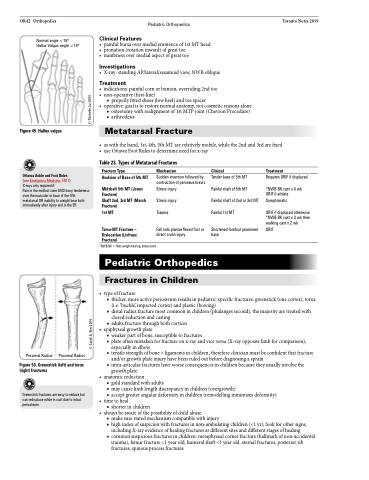Page 976 - TNFlipTest
P. 976
OR42 Orthopedics
Pediatric Orthopedics
Toronto Notes 2019
Normal angle <15o Hallux Valgus angle >15o
Clinical Features
• painfulbursaovermedialeminenceof1stMThead • pronation(rotationinward)ofgreattoe
• numbnessovermedialaspectofgreattoe
Investigations
• X-ray:standingAP/lateral/sesamoidview,NWBoblique
Treatment
• indications:painfulcornorbunion,overriding2ndtoe • non-operative(first-line)
■ properly fitted shoes (low heel) and toe spacer
• operative:goalistorestorenormalanatomy,notcosmeticreasonsalone
■ osteotomy with realignment of 1st MTP joint (Chevron Procedure) ■ arthrodesis
Metatarsal Fracture
• aswiththehand,1st,4th,5thMTarerelativelymobile,whilethe2ndand3rdarefixed • useOttawaFootRulestodetermineneedforx-ray
Figure 49. Hallux valgus
Ottawa Ankle and Foot Rules
(see Emergency Medicine, ER17)
X-rays only required if:
Pain in the midfoot zone AND bony tenderness over the navicular or base of the fifth metatarsal OR inability to weight bear both immediately after injury and in the ER
Table 23. Types of Metatarsal Fractures
Fracture Type
Avulsion of Base of 5th MT
Midshaft 5th MT (Jones Fracture)
Shaft 2nd, 3rd MT (March Fracture)
1st MT
Tarso-MT Fracture – Dislocation (Lisfranc Fracture)
*NWB BK = Non weight bearing, below knee
Mechanism
Sudden inversion followed by contraction of peroneus brevis Stress injury
Stress injury Trauma
Fall onto plantar flexed foot or direct crush injury
Clinical
Tender base of 5th MT Painful shaft of 5th MT Painful shaft of 2nd or 3rd MT Painful 1st MT
Shortened forefoot prominent base
Treatment
Requires ORIF if displaced
*NWB BK cast x 6 wk ORIF if athlete Symptomatic
ORIF if displaced otherwise *NWB BK cast x 3 wk then walking cast x 2 wk
ORIF
Pediatric Orthopedics
Fractures in Children
Proximal Radius
Proximal Radius
• typeoffracture
■ thicker, more active periosteum results in pediatric-specific fractures: greenstick (one cortex), torus
(i.e. ‘buckle’, impacted cortex) and plastic (bowing)
■ distal radius fracture most common in children (phalanges second), the majority are treated with
closed reduction and casting
■ adults fracture through both cortices
• epiphysealgrowthplate
■ weaker part of bone, susceptible to fractures
■ plate often mistaken for fracture on x-ray and vice versa (X-ray opposite limb for comparison),
especially in elbow
■ tensile strength of bone < ligaments in children, therefore clinician must be confident that fracture
and/or growth plate injury have been ruled out before diagnosing a sprain
■ intra-articular fractures have worse consequences in children because they usually involve the
growth plate
• anatomicreduction
■ gold standard with adults
■ may cause limb length discrepancy in children (overgrowth)
■ accept greater angular deformity in children (remodelling minimizes deformity)
• timetoheal
■ shorter in children
• alwaysbeawareofthepossibilityofchildabuse
■ make sure stated mechanism compatible with injury
■ high index of suspicion with fractures in non-ambulating children (<1 yr); look for other signs,
including X-ray evidence of healing fractures at different sites and different stages of healing
■ common suspicious fractures in children: metaphyseal corner fracture (hallmark of non-accidental
trauma), femur fracture <1 year old, humeral shaft <3 year old, sternal fractures, posterior rib fractures, spinous process fractures
Figure 50. Greenstick (left) and torus (right) fractures
Greenstick fractures are easy to reduce but can redisplace while in cast due to intact periosteum
© Sarah A. Kim 2005
© Michelle Lui 2004


